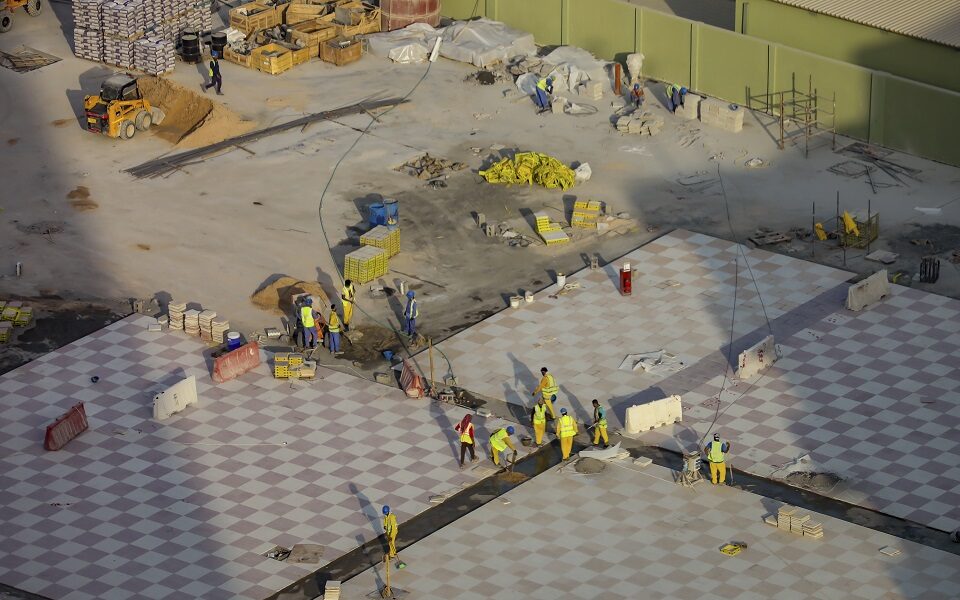The World Cup’s forgotten team

BHOKTENI, Nepal – Shambhu Chaudhary accepts the cellphone and takes a long look at the man in the photograph. He is dressed in a dark suit and standing in bright sunshine at the center of what appears to be a giant construction project. At first, Chaudhary does not recognize the man. But he recognizes the place immediately.
“Lusail,” Chaudhary says, naming the gleaming $1 billion facility that is the centerpiece of Qatar’s World Cup. “I built that stadium.”
Chaudhary, 44, probably will not watch the World Cup matches that will be played this month and the next at Lusail, when the stadium he helped build will attract star players, global celebrities, heads of state and a television audience of more than a billion people for the final on Dec. 18. None of it would have been possible, though, without hundreds of thousands of men like him: the migrant workers who fuel the ruthlessly capitalist business of supply and demand that does much of the daily and dangerous work in the searing heat of the Persian Gulf, and who were indispensable to the $220 billion nation-building project that will culminate in the first World Cup in the Arab world.
Qatar’s preparations for the tournament have shined a spotlight on that army of workers who have done nothing less than redraw the country over the past decade, as well as on the system that exploits their labor and their desperation, and has cost thousands of them their lives.
The workforce is so large and drawn from so many places that its numbers seem impossible to count. It is a group so anonymous that, to this day, no one is able to agree on how many of its members died to get the World Cup across the finish line.
Human rights organizations have put the death toll in the thousands. The official count by Qatari organizers – which they carefully limit to deaths on projects directly linked to the tournament – is 37, and only three if just workplace accidents are counted. Each life, though, has a story.
Chaudhary takes another look at the photo.
“I’ve seen his face before – he’s very high, very important,” Chaudhary says, raising his hands above his head. He then finally recognizes Gianni Infantino, the president of FIFA, the governing body of world soccer.
Infantino made headlines in May when he said that those who had constructed the World Cup stadiums should feel “dignity and pride” in their work.
Chaudhary shrugged. To him, the stadium was just another building, just another job.
“For me,” he says, “work and money is more important than football.”
Fuel for the machine
Crammed between the regional superpowers India and China, Nepal, a nation of little industry but of a large and eager workforce, may be the perfect setting to explain the meeting of ambition and necessity that built this year’s World Cup.
Nepal has struggled for decades to provide meaningful opportunities for large parts of its population, particularly for those who live in the countryside. Trapped between poverty, despair and necessity, hundreds of thousands of those citizens now look for work abroad every year instead.
Only India, an exponentially larger country, has sent more workers than Nepal to the work sites and construction jobs of Qatar in the past decade: 204,000 were granted labor permits in 2015 alone, near the height of the World Cup construction boom. The government estimates that they are part of an ongoing exodus that has seen more than 25% of Nepal’s population migrate to work overseas since records related to such work started being collected in 1994.
Exported labor is so vital to Nepal’s economy that there are not one but two government departments dedicated to migration. Krishna Prasad Bhusal, a spokesman for one of them, the Department of Foreign Employment, said 650,000 Nepalis left on foreign employment contracts in the last year alone. According to government figures, the remittances they send home account for a quarter of the country’s national income, a higher percentage than all but six other nations. Migrant jobs, he said, “will be important for many years.”
So high are the power imbalances, though, and so valuable are the jobs that even migrant labor activists in the country admit they sometimes fear pushing too hard for reforms. There are, after all, plenty of poor people in neighboring countries competing for the work, and for the money it brings home.
At the same time, Nepal may have paid a higher price for its migrant labor than other nations. At least 2,100 Nepali workers have died in Qatar since 2010, the year it won the World Cup hosting rights, according to data collated by Nepal’s labor ministry. (Large numbers have died elsewhere, too: more than 3,500 in Malaysia; almost 3,000 in Saudi Arabia; at least 1,000 in the United Arab Emirates.)
These workers succumb to an array of ailments – premature heart attacks and unexplained heat-related health problems that one local official described as “environmental disadaptation” – that no one has committed to studying but will eventually kill thousands more of them. There have also been an alarming number of suicides over the past decade, with almost 200 recorded among Nepali migrant workers in Qatar.
Bishwa Raj Dawadi, a doctor on a committee that examines death certificates and migrant worker injuries for the labor ministry, has noticed another worrying trend: young laborers suffering from kidney failure after returning from the Persian Gulf. He said many return to their villages without getting the treatment required; many die within two years of returning home.
“I am depressed because they are all young men,” he said.
The dead are disproportionately men between 20 and 45, all of whom would have undergone government-ordered medical exams before being allowed to work abroad. “It really is a mysterious thing because they are medically fit from here,” said Anjali Shrestha, an official at the foreign employment board. “Yes, of course people in Nepal also die. But not like this.”
Hundreds of those who return in coffins are categorized as “natural deaths,” and no autopsies are ever carried out.
Chaudhary, a heavyset man with a thin mustache, heads to the back of his home to fetch a bag. He reaches into it and pulls out a square bottle of orange and white capsules. They are part of a daily regimen he says is now required after having dizzy spells and collapsing while working under the desert sun. “It’s hot,” he said, “but what are we going to do?”
Others, he knows, have suffered far worse.
Sanju Jaiswal, 24, and her husband, Amrish, had high hopes about how his new job in Qatar would change their family’s fortunes. There was even talk about moving to Kathmandu, Nepal’s capital, so their three children could have a better education. A job as a motorbike courier offered a path to that life. But Amrish died within five months after arriving in Doha, Qatar’s capital, last October, run down by a car while making a food delivery.
Dabbing away tears with a thin shawl she wears to cover her hair, Jaiswal said her future was now uncertain. Her relationship with her in-laws has grown tenuous and bills are piling up. The local school said it would soon suspend her children – all under 10 – unless she quickly cleared their overdue fees.
“This is the most heartbreaking situation for me,” Jaiswal said as her youngest child, craving attention, tugged at her sleeve.
Despondent since her husband’s death, Jaiswal has developed a macabre habit, scouring the social media platform TikTok for stories about other bereaved families.
They are not hard to find.
The way out
The departure board at Nepal’s main international airport offers a vivid look at its population’s dependence on overseas work.
On a Thursday morning last month, multiple flights were leaving for Dubai, United Arab Emirates; Doha; Abu Dhabi, UAE; and Kuala Lumpur, the capital of Malaysia, the biggest employer of Nepalis outside the Persian Gulf countries. Departing passengers are funneled into one of three lines: one for Nepalis, another for foreigners and another marked by a board that reads, “Nepali Migrant Workers.” That lane was by far the busiest.
Bigyan Rai, 32, said he had worked in television advertising and as a model in his younger days before the jobs dried up. Standing in line at the airport, he was leaving his country, his family and his 10-month-old son. He has no better option, he said, amid a lack of opportunities and the endemic corruption of a system that takes advantage of the powerless.
“Sometimes,” he said, “I feel very unlucky to be Nepali.”
In Kathmandu, billboards, walls and buses are plastered with advertisements offering visa and work placement services as far as Canada, Australia, Japan and South Korea. But the siren of overseas jobs is heard loudest in the countryside.
In many ways then, there is nothing remarkable about the village of Sonigama, a collection of mostly mud-and-timber buildings surrounded by row upon row of sugar cane and paddy fields. Like nearly every town and village in Nepal, Sonigama is the kind of place that men willing to work are looking to leave.
At the edge of the village, Tetri Sharma is sitting on the grassy knoll next to a pond, waiting for a ride to a neighboring village. Sharma says two of her sons are in the Persian Gulf region, one in Qatar and another in a place she cannot recall. A few minutes later, a man named Ram Prasad Mandal approaches the water. Dressed in a sarong and a stained white T-shirt, he is leading a buffalo toward the water with a wooden staff. Mandal, 55, says he, too, has a son in the region. His oldest son, Upendra, is working as a cleaner in Dubai.
Mandal says the need for money is urgent. He cannot afford a dowry for his daughter, Babita; without one, he says, she will never marry. Every day Upendra spends in Dubai, every rupee he sends home, brings Babita’s wedding day a little closer.
“Boys come with a marriage proposal if you have money,” Babita’s mother says as Babita stands quietly alongside her, head lowered.
Neighbors soon gather, and other stories pour out. Nearly every villager has experienced working as a migrant laborer or has a relative overseas. The ones who have not, the locals say, are desperate to go.
Shiva Kumar Sada is among them. For now, he says, all there is to do is “time pass,” a common euphemism in South Asia that refers to idling. The only work he has is weaving baskets out of bamboo, which takes all day to complete and earns maybe a quarter of what he might make for a day’s labor in the Persian Gulf.
Kumar Sada knows life abroad can be hard. He was at a worker protest over unpaid salaries in Saudi Arabia in 2018 that ended with soldiers’ firing live rounds into crowds. But that has not put him off from returning. He is desperate to go back. The reason, he said, is simple.
“Money,” he says in English, rubbing his thumbs. “Food,” he adds, bringing one of his hands to his mouth.
Paying to work
Migrant laborers sit at the bottom end of an employment chain that begins with a foreign company seeking workers and leads to a recruitment firm engaged to source them and agents who beat the bushes for eager applicants. Before they can even get jobs overseas, though, families first must plunge themselves into far worse financial straits.
To get one of the coveted jobs, prospective migrants have to borrow thousands of dollars – at annual interest rates of 30% or more – to pay recruitment fees that are typically more than $2,000, about 25 times the amount recruiters can legally demand. That can represent several months of salary promised away even before a worker leaves Nepal.
Chaudhary, like millions of others, saw no option but to pay the fee, racking up debts that have only grown in the years since he first went abroad. An attempt to bring his eldest son, Santosh, to Qatar five years ago failed when the boy’s employer discovered he was underage. He was forced to return to Nepal, the agent fee lost.
Nepal has in recent years signed agreements with recruiting countries to limit such costs, but on the ground there is little sign of change, said Dwarika Upreti, the executive director of the foreign employment board. Recruitment companies, thanks to their financial heft and political connections, are able to evade most legal consequences, and the demand for labor in places like Qatar makes it worth the risk. Recruiting countries also rarely check if rules have been followed.
Some frauds are more brazen. In Kathmandu, Krishna Magar said he beat stiff competition to secure a coveted two-month posting as a security guard at the World Cup. He was told the visa and the flights would be taken care of by his employer, but as he prepared to depart, a Nepalese recruitment agent suddenly demanded a quarter of the $1,000 he was expecting to earn.
Magar was furious. “They are threatening to cancel my visa,” he said, standing outside an office where a steady stream of hopeful migrants comes daily to file complaints. But desperate to work, and running out of time, he hoped bringing attention to his case would free him of the shakedown attempt, and secure his passage to Qatar – and to the job he had been assured was waiting for him.
World Cup officials have for years bristled at criticism over the treatment of migrant workers, both in Qatar and in their home countries, calling the attacks unfair and noting they have made progress in improving conditions. That includes establishing a minimum wage ($275 per month) and the abolishment of a punitive system called kafala that allowed employers to hold their workers’ passports, making leaving the country or changing jobs effectively impossible for them without permission.
Critics point out that Qatar’s biggest changes only took place after much of the major construction was completed or were narrowly applied only to World Cup projects, and that enforcement remains patchy. But it hardly matters: Many migrants remain unaware of Qatar’s labor reforms or of its new protections for workers. Wage theft, according to outside groups, remains common.
“This event was entirely built on the backs of migrant workers, on a completely unequal balance of power,” said Michael Page, a deputy director in the Middle East and North Africa division at Human Rights Watch. “All these abuses have been entirely predictable.”
Dishonesty drives the labor machine. In Nepal, the rare recruiters who are wary of prosecution sometimes create their own type of insurance: videotaped statements of candidates falsely affirming that they have paid only the legal maximum in fees, 10,000 Nepali rupees, or about $75. “We have to lie,” said one migrant, part of a group hired to work security in Abu Dhabi that was interviewed at the airport.
He and others in his group freely revealed that they all had been coached to lie to immigration officials; all said they had paid at least 30 times the $75 amount. But getting it back is impossible; the money quickly disappears, untraceable. In one case, a migrant in the same group said, four or five agents in a recruitment office fought over their shares of a wad of cash almost immediately after he handed it over.
The work never ends
Under a cloudless sky, a barefoot Shambhu Chaudhary dips his right hand into a bucket outside his modest home and swirls its contents, a mixture of earth and water, and then rubs fistfuls of the paste onto a wall. His house remains a work in progress.
Inside the two-story structure there is almost no natural light and little furnishing. Meals are cooked over an open fire in a kitchen, which is separated from the main room by a mud wall. Chaudhary, who most recently worked as a plasterer in Qatar, has become an expert at building walls.
All around him are reasons he has spent much of his adult life away from his wife and two children, why he has endured hard work in inhospitable conditions, why he is still desperate to return.
There is his unfinished home. There are the groups of men of idling nearby, unable to find work. There is his 11-year-old son, Sajan, who is deaf, partly blind and paralyzed. And there is his older son, Santosh.
There is no work for Santosh, 22, in Bhokteni, Nepal. His plan is to try again to find work overseas, the sort his father has done for two decades. Now it is his turn, his chance to assume the role as the family’s primary breadwinner.
He might even end up building more stadiums under the white-hot desert sun: Infantino, FIFA’s president, has encouraged Qatar’s neighbor, Saudi Arabia, to bid for the 2030 World Cup.
This article originally appeared in The New York Times.






